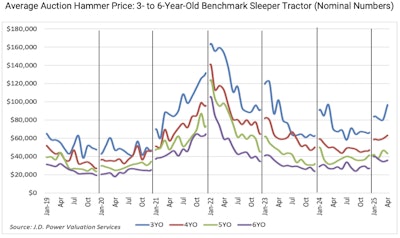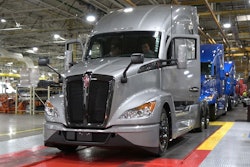
The used truck auction market saw a drop in volumes lead to a boost in price in April, J.D. Power reported Thursday in its May Commercial Truck Guidelines report.
Following a very strong start to “selling season” in March, J.D. Power states volume decreased more than expected in April.
Among late-model sleeper tractors, average pricing for J.D. Power's benchmark truck in April was:
- Model year (MY) 2023: $96,735; $16,472 (20.5%) higher than March
- MY 2022: $63,152; $3,542 (5.9%) higher than March
- MY 2021: $43,470; $3,118 (6.7%) lower than March
- MY 2020: $35,917; $1,428 (4.1%) higher than March
- MY 2019: $28,639; $141 (0.5%) higher than March
The company says selling prices for the 4- to 6-year-old cohort of its benchmark truck in April averaged 1.3% more than March and 30.3% higher than April 2024. J.D. Power states pricing for that group is currently 19.4% higher than the strong pre-pandemic period of 2018 in nominal figures (6.0% lower if adjusted for inflation), and 91.1% higher than the last market nadir in late 2019 (53.6% higher when adjusted for inflation).

J.D. Power adds trucks with under 300,000 miles brought extremely strong money in April, suggesting end users are competing for lightly-used trucks. This development explains the very wide swing in value for model-year 2023 trucks in the table above, and points to healthier bidding activity in a tightening supply environment. That observation, combined with the temporary rollback of tariffs on Chinese products, makes J.D. Power more bullish on used truck conditions in the short term.
[RELATED: Recent data shows higher used truck pricing underway]
Higher demand combined with lower supply is Economics 101, the company adds.
Time constraints made retail data unavailable this month though J.D. Power states it will provide that data again in its next edition.
Overall, the company states the recent temporary rollback of tariffs on Chinese imports comes just in time to reverse the post- pull-ahead slump. However, a 90-day agreement does not provide certainty for longer-term planning, so potential new truck buyers remain cautious.
[RELATED: Vermont, Oregon pause adoption of California emission regs]
"Diving deeper into the new truck environment, model-year 2027 emissions regulations are in flux, not yet officially canceled on paper but also not likely to be enforced. However, R&D and manufacturing changes were complete well before the regulatory change, and increased costs are already baked in to 2027 pricing (with the possible exception of the extended warranty requirement)," J.D. Power says.
"In the midst of all this, freight still needs to be moved and old trucks still need to be replaced, which is why we’re seeing improved conditions at auctions and on dealer lots, particularly for the low-mileage trucks that can function as a substitute for new."
For more information, and to read the entirety of this month’s report, please CLICK HERE.










